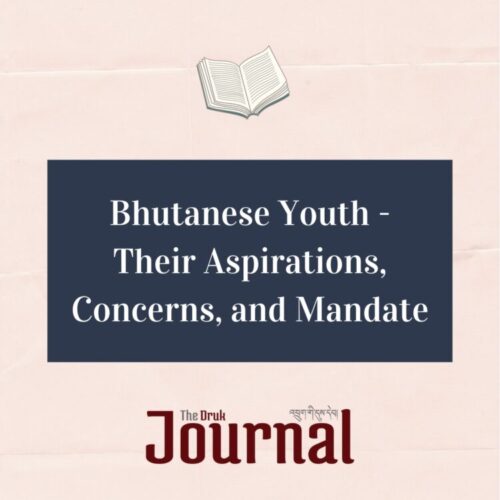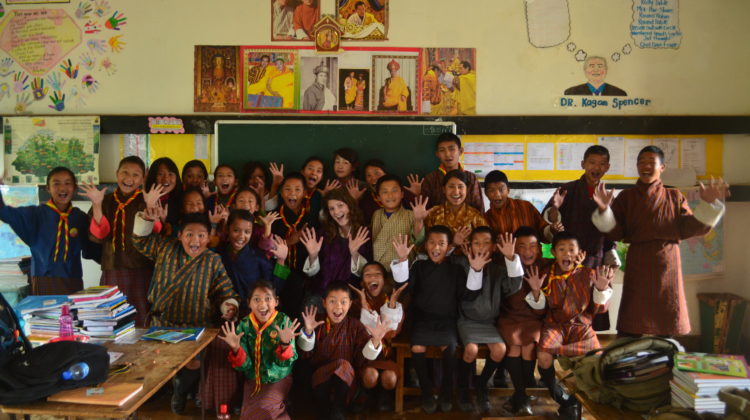* This Think Piece originally appeared as an article in The Druk Journal volume titled: Bhutanese Youth- Their Aspirations, Concerns, and Mandate (Volume 7, Issue 2; Autumn 2021). The original can be found here. BCF thanks The Druk Journal for its kind permission to post the article in our Think Piece series. The views expressed in the article are the author’s.
Author: Norbu Wangchuk
The importance of technical and vocational (TVET) skills in the process of nation-building was recognised early in Bhutan’s socio-economic development plans. As the country prioritised education and started building the so-called modern school system, the first TVET institute, Kharbandi Technical School (1965), was established in the first Five Year Plan (1961-1966), followed by the Royal Bhutan Polytechnic in 1972, and the National Technical Training Authority in 1999.
But, nearly 60 years later, the job markers are characterised by a persistent disconnect between the demands on TVET systems and the skills supplied, resulting in perpetual unemployment problems.
The Bhutan Trade Integration Strategy Update 2020 reported Bhutan as a labour-poor and unskilled country and identified the lack of a skilled workforce as the biggest inhibitor to the country’s growth and economic competitiveness. The Enterprise Survey of 2014 (conducted to measure employers’ perceptions of skills demand) found that 36 percent of the establishments faced difficulties in recruiting workers with the right type of skills, underscoring the perpetual issue of skills mismatch.
The COVID-19 pandemic has aggravated the fragile labour market and affected the national economic situation. The overall unemployment rate has increased from 2.7 percent to 5 percent in 2020, with youth unemployment rate increasing from 11.9 percent in 2019 to 22.6 percent, leaving about 7,000 young Bhutanese either unemployed or seeking employment in 2020. A draft 21st Century Economic Road Map projects close to 100,000 youths entering the labour market in the coming decade, many of whom will require and seek to acquire some form of skilling.
A national paradox is that, while the unemployment rate continues to climb, certain sectors of the economy such as construction, manufacturing, and even agriculture continue to face workforce shortages. This situation can be observed from the increasing demand for foreign workers in business establishments, particularly in the construction sector. The demand for foreign workers in the construction industry has been increasing annually, reaching 60,000 in 2019 (excludes hydropower). Most of them were employed for a range of tasks, many of which can be performed by the Bhutanese workforce.
This paper proposes a policy to transform the profile of TVET training and preparedness, based on the requirement of Bhutan’s growth trajectory. The policy and the plan attempt to follow the education reform commanded by His Majesty The King in December, 2020.
Turn Around
Given the changing and unfulfilled labour market challenges, His Majesty the King emphasised the need to radically transform the TVET system of Bhutan into a “responsive, resilient, and agile” system that is as much local as it is trans-local. The Royal Decree on Education Reform conveys a special concern and commitment, determination, and vision to Bhutanese youth and children:
Our generation has the sacred responsibility of radically rethinking our education system and transforming curriculum, infrastructure, classroom spaces, and examination structures. Educationists and experts have identified what twenty-first century competencies mean for children everywhere. By developing their abilities for critical thinking, creative thinking, and learning to be life-long learners, we have to prepare them to be inquisitive, to be problem-solvers, to be interactive and collaborative, using information and media literacy as well as technological skills.
His Majesty’s vision for education reform underscores the need for a new direction for the education sector to prepare Bhutan for the 21st Century. It calls for an urgent need to restructure the education system and processes to be relevant to a different social and economic context, and for the reform process to aim for standards and goals of the highest possible order.
Inspired
The planners of the Ministry of Labour and Human Resources (MoLHR) believe that sustenance of the industrial sector is entirely dependent upon the availability of trained manpower for the multidimensional activities needed to keep the wheel of industry running. Bearing in mind the ability of individuals, industry, and nations to meet the competitive challenges of an increasingly global economy is irrevocably bound to a good TVET system, MOLHR is transforming Bhutan’s TVET system.
The overall objective of the reform initiative is to transform TVET into an attractive learning and career pathway by putting in place an agile, responsive, and robust TVET system that is capable of producing a workready and future- ready workforce. What the Ministry has learnt from the Royal vision is that the standard and quality of Bhutan’s TVET workforce cannot be compromised. The Bhutanese workforce must be trained to be the best by global standards.
The Strategy
Four core transformation strategies are proposed to advance the reform initiative, commonly referred to as “4 Ps” — Place, Product, People and Process. These transformation strategies were deployed by Singapore (Institute of Technical Education) in the late 1990s as part of their successful TVET transformation journey. Today, Singapore’s TVET model is recognised globally.
The Ministry found these strategies appropriate and relevant, with minor modification, to be applied to reform Bhutan’s TVET system, and adopted the same as the main transformation strategies. These strategies will essentially focus on Place – Building TVET institutions that provide appealing, authentic, and ICT-enabled learning environment; Product – Delivering TVET programmes that are designed to adequately equip students with 21st Century skills and IR 4.0 competencies; People – Nurturing a pool of committed, motivated, and competent TVET leaders and professionals willing to trail-blaze Bhutan’s TVET to a global standard; and Process – Put in place responsive, sustainable, agile, and high-performing TVET institutions and systems.
Place Transformation Pillar will focus on renovation, re-modification and construction of new physical as well as ICT infrastructure and facilities to support authentic learning, enabled by ICT and digital technologies. It will ensure putting in place common minimum infrastructure (such as adequate classrooms, workshops, hostels, library, labs, indoor and outdoor sports facilities, recreation amenities, lecture theatres, etc) to promote holistic learning and student development.
Concurrently, it aims to expand the total intake capacity of the existing six Technical Training Institutes (TTIs) and two Institutes for Zorig Chusum (IZCs), from the current 1,700 to more than 4,000. For better coordination and coherence, the pillar will also study the governance system for other public TVET providers that are currently not under the purview of the MoLHR, such as the Royal Institute of Tourism and Hospitality, Royal Academy of Performing Arts, etc.
Product Transformation Pillar will work towards diversification of the TVET courses in line with the emerging needs of the local as well as translocal economy. The focus will be on diversifying TVET course offerings to meet the growing needs of the industry – in construction, creative industries, arts and crafts, automobile, agro business, tourism, hospitality, ICT and digital industry.
To cater to the immediate skills need of the economy and in consultation with the industry, the reform plan will have more than 90 courses for implementation. The proposed range of courses includes computer application and digital technology, electronics and mechatronics, transport and logistics, business and services, tourism and hospitality, creative arts, engineering and construction, media, communication and green skills.
While a majority of the proposed courses is oriented towards addressing the needs of the local economy, a few courses (mostly computer applications and digital technology) are being planned to harness the opportunity of the global labour market. Most of the identified courses will be run by the technical training institutes which are located in Thimphu, Wangdue Phodrang, Punakha, Bumthang, Trashigang, Trashiyangtse and Sarpang. Additionally, the pillar plans to review and undertake a major overhaul of the TVET Programme Design and Development system – starting from standard development, TVET delivery, work-based learning, and assessment and certification by benchmarking to the global models.
People Transformation Pillar aims to develop a critical poll of TVET leaders and professionals who are willing to invest their time and resources in taking Bhutan’s TVET system to global standards. It will essentially focus on building the capability of the TVET leaders and managers assuming leadership positions in the Ministry, Departments, and the Training Institutes in setting clear policy direction and strategic vision.
Among others, the strategy will also focus on continuous capacity building (both in-country and ex-country) of the TVET lecturers/instructors in core competencies and digital skills required for effective TVET delivery, recruit TVET experts and lecturers from abroad to deliver TVET courses and transfer knowledge. It will also implement a Talent Management System that is capable of attracting and retaining the best TVET professionals to continue to work in the TVET System.
Process Transformation Pillar will focus on building a TVET system that is robust, sustainable and agile to respond to the emerging labour market challenges. Main strategic interventions include streamlining TVET governance and institutional mechanism to bring coherence in the management of TVET affairs; institutionalising a dynamic and robust TVET and Labour Market Information system to provide real time and useful labour market information. It includes the development of maps and skills framework to address skills mismatch, strengthening local and international partnership and linkages for global competitiveness, putting in place a functional and dynamic learning and career pathway, and diversify TVET financing. It will also study and streamline policies and procedures that are currently limiting the agility of the TVET system.
Conclusion
The journey towards the reformed TVET system of Bhutan has begun. The drafting of the national TVET Policy is nearing completion. Concurrently, the TVET Reform Strategic Plan was approved by the Government in August, 2021. The TVET Policy and the Strategic Plan will provide the overall framework and a clear road map to guide the TVET stakeholders in collectively pursuing the reform objective, which is to enhance the responsiveness and agility of Bhutan’s TVET system in preparing the Bhutanese workforce for the 21st Century challenges.
The expansion, modification, and renovation of the technical training institutes have begun. Construction of a model technical training institute at Serbithang with an enrollment capacity of more than 300 trainees, started in 2020. Once complete, the institute will offer automotive technology and ICT related courses. Likewise, expansion of the technical training institute at Samthang and renovation of the Institute of Zorigchusum in Thimphu are ongoing.
Sourcing of international architects to develop conceptual design (to guide facility development as envisaged in the strategic plan) for other training institutes is currently under negotiation. Topographical survey of all the technical training institutes was done. Assessment of the ICT and digital infrastructure requirement in all the training institutes has been outsourced to a consultant.
Orders for procurement of industry relevant tools, equipment, and computers have been placed. Six new training vehicles (Hyundai and Isuzu models) were procured and supplied to three training institutes offering automobile courses. Upgradation of workshops, classrooms, and provision of adequate and relevant tools and equipment will continue to create an authentic learning ambience at the training institutes.
Eleven international Master Trainers have been recruited so far. The Master Trainers supported the review and development of occupational standards and curricula in line with global models. Besides delivering courses of their specialisation, the Master Trainers also provided Training of Trainers (TOT) programmes to the instructors and industry professionals. Acknowledging their contribution to the reform objectives, the recruitment of Master Trainers covering a range of occupations will continue in the coming days. Establishment of linkages with the Institute of Technical Education (Singapore), TAFE (Technical and Further Education) Australia, and Humber College (Canada) has reached an advanced stage. Likewise, linkages with institutes in other developed countries will be explored.
The vision and urgency of the TVET reform have been clearly spelt out in the Royal Kasho on education reform. The Ministry of Labour and Human Resources will leave no stone unturned translating the Royal vision into tangible labour market outcomes. However, the ultimate success of reforming Bhutan’s TVET System from a last-resort education to being the “jewel” of Bhutan’s education system will largely depend on the collective effort and wisdom of the Bhutanese people.







